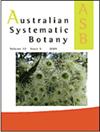澳大利亚北部地区的Charophytes - I. Tribe Chareae
IF 1.6
3区 生物学
Q4 EVOLUTIONARY BIOLOGY
引用次数: 1
摘要
摘要本研究记录了北领地轮藻科轮藻族3属22种,包括15个先前描述的物种(Chara benthamii、C.erythorgyna、C.globularis、C.karolii、C.lucida、C.porteri、C.protocharoides、C.setosa、C.submolusca、C.wightii、C.zeylanica、Lamprothamnium capitatum、L.compactum、L.stipitatum、Lychnothamnus barbatus),其中2个是澳大利亚植物群的新物种(C.erythongyna和C.wighti),以及5个品种(C.aridicola、C.arnhemensis、C.bancroftii、C.behriana、C.duruscula)和2个新描述的物种(C.lamprothamunifis、C.schultae)。在本研究中,该部落中先前报告的三个物种(C.braunii、C.corallina和C.fibrosa)没有记录在北领地,因为之前的记录是基于错误的识别或地点。虽然北领地没有发现倒刺石竹的标本,但它已被纳入这一处理范围,因为它发生在昆士兰东南部、卡奔塔利亚湾、巴布亚新几内亚和东帝汶。提供了所有物种的钥匙、插图和描述。本文章由计算机程序翻译,如有差异,请以英文原文为准。
Charophytes of Australia’s Northern Territory – I. Tribe Chareae
ABSTRACT This study of Northern Territory charophytes documents 22 species in 3 of the genera in tribe Chareae, family Characeae, including 15 previously described species (Chara benthamii, C. erythrogyna, C. globularis, C. karolii, C. lucida, C. porteri, C. protocharoides, C. setosa, C. submollusca, C. wightii, C. zeylanica, Lamprothamnium capitatum, L. compactum, L. stipitatum, Lychnothamnus barbatus) of which 2 are new for the Australian flora (C. erythrogyna and C. wightii), as well as 5 varieties raised to species rank (C. aridicola, C. arnhemensis, C. bancroftii, C. behriana, C. duriuscula), and 2 newly described species (C. lamprothamniformis, C. schultae). Three previously reported species in the tribe (C. braunii, C. corallina, C. fibrosa) are not recorded from the Northern Territory in this study, as previous records were based on erroneous identifications or localities. Although Northern Territory specimens of Lychnothamnus barbatus have not been seen, it has been included in this treatment, because it occurs in south-eastern Queensland, the Gulf of Carpentaria, Papua New Guinea and Timor-Leste. A key, illustrations and descriptions of all the species are provided.
求助全文
通过发布文献求助,成功后即可免费获取论文全文。
去求助
来源期刊

Australian Systematic Botany
生物-进化生物学
CiteScore
3.10
自引率
12.50%
发文量
12
审稿时长
>12 weeks
期刊介绍:
Australian Systematic Botany is an international journal devoted to the systematics, taxonomy, and related aspects of biogeography and evolution of all algae, fungi and plants, including fossils. Descriptive taxonomic papers should normally constitute a comprehensive treatment of a group. Short papers on individual species and nomenclatural papers must contain significant new information of broader interest to be considered. The prestigious L.A.S. Johnson Review Series is published. Other review articles will also be considered. All papers are peer reviewed.
Australian Systematic Botany is published with the endorsement of the Commonwealth Scientific and Industrial Research Organisation (CSIRO) and the Australian Academy of Science.
 求助内容:
求助内容: 应助结果提醒方式:
应助结果提醒方式:


